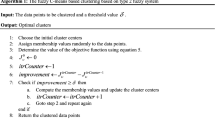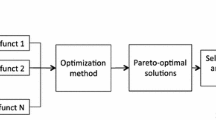Abstract
In this article, a new method is proposed for biomedical image segmentation. The proposed method for biomedical image segmentation will be known as fuzzy modified cuckoo search (FMCS). This method falls under the category of unsupervised classification (i.e., clustering). In this work, the concept of a well-known metaheuristic method called cuckoo search is extended, modified, and combined with the modified type 2 fuzzy C-means algorithm, and the name is given accordingly. FMCS method uses a modified cuckoo search to find the optimum cluster centers based on fuzzy membership. The proposed FMCS technique fuses the idea of type 2 fuzzy sets with the MCS strategy, and it is applied in biomedical images segmentation. The proposed approach assists with deciding the clusters without having any affectability on the choice of the underlying centers. The quantity of the control variable for the MCS technique is very sensible contrasted with numerous other metaheuristics approaches. The MCS strategy can come to the global optima even subsequent to stalling out in a neighborhood optimum. The proposed method is applied to different biomedical images and compared with several standard optimization methods like genetic algorithm, particle swarm optimization, cuckoo search, etc. The proposed method does not suffer from the choice of initial cluster centers because it exploits the random behavior of the cuckoo search to initialize the cluster centers. Moreover, FMCS outperforms some of the standard methods in terms of the rate of convergence and other segmentation parameters. The proposed approach blends the type 2 fuzzy system in the modified cuckoo search procedure for efficient biomedical image segmentation. The superiority of the proposed method is verified by both quantitative and qualitative measures.














Similar content being viewed by others
References
Qaiser T, Tsang Y-W, Taniyama D et al (2019) Fast and accurate tumor segmentation of histology images using persistent homology and deep convolutional features. Med Image Anal 55:1–14. https://doi.org/10.1016/J.MEDIA.2019.03.014
Zhang R, Chung ACS (2021) MedQ: lossless ultra-low-bit neural network quantization for medical image segmentation. Med Image Anal 73:102200. https://doi.org/10.1016/J.MEDIA.2021.102200
Liu Q, Chen C, Qin J et al (2021) FedDG: federated domain generalization on medical image segmentation via episodic learning in continuous frequency space, pp 1013–1023
Gao Y, Zhou M, Metaxas DN (2021) UTNet: a hybrid transformer architecture for medical image segmentation, pp 61–71. https://doi.org/10.1007/978-3-030-87199-4_6
Wang K, Zhan B, Zu C et al (2021) Tripled-uncertainty guided mean teacher model for semi-supervised medical image segmentation, pp 450–460. https://doi.org/10.1007/978-3-030-87196-3_42
Tseng K-K, Zhang R, Chen C-M, Hassan MM (2020) DNetUnet: a semi-supervised CNN of medical image segmentation for super-computing AI service. J Supercomput 77(4):3594–3615. https://doi.org/10.1007/S11227-020-03407-7
Liu X, Thermos S, O’Neil A, Tsaftaris SA (2021) Semi-supervised meta-learning with disentanglement for domain-generalized medical image segmentation, pp 307–317. https://doi.org/10.1007/978-3-030-87196-3_29
Zeng G, Lerch TD, Schmaranzer F et al (2021) Semantic consistent unsupervised domain adaptation for cross-modality medical image segmentation, pp 201–210. https://doi.org/10.1007/978-3-030-87199-4_19
Baur C, Denner S, Wiestler B et al (2021) Autoencoders for unsupervised anomaly segmentation in brain MR images: a comparative study. Med Image Anal 69:101952. https://doi.org/10.1016/J.MEDIA.2020.101952
Huang Q, Zhou Y, Tao L et al (2021) A Chan-Vese model based on the Markov chain for unsupervised medical image segmentation. Tsinghua Sci Technol 26:833–844. https://doi.org/10.26599/TST.2020.9010042
Xu Y, Zhu J-Y, Chang EI-C et al (2014) Weakly supervised histopathology cancer image segmentation and classification. Med Image Anal 18:591–604. https://doi.org/10.1016/J.MEDIA.2014.01.010
Torrents-Barrena J, Piella G, Masoller N et al (2019) Segmentation and classification in MRI and US fetal imaging: recent trends and future prospects. Med Image Anal 51:61–88. https://doi.org/10.1016/J.MEDIA.2018.10.003
Zadeh LA (1965) Fuzzy sets. Inf Control 8:338–353. https://doi.org/10.1016/S0019-9958(65)90241-X
Bezdek JC, Ehrlich R, Full W (1984) FCM: the fuzzy c-means clustering algorithm. Comput Geosci 10:191–203. https://doi.org/10.1016/0098-3004(84)90020-7
Tolias YA, Panas SM (1998) Image segmentation by a fuzzy clustering algorithm using adaptive spatially constrained membership functions. IEEE Trans Syst Man Cybern Part A Syst Hum 28:359–369. https://doi.org/10.1109/3468.668967
Yang XS, Deb S (2009) Cuckoo search via Levy flights. In: 2009 world congress on nature and biologically inspired computing, NABIC 2009—Proceedings, pp 210–214
Walton S, Hassan O, Morgan K, Brown MR (2011) Modified cuckoo search: a new gradient free optimisation algorithm. Chaos Solitons Fractals 44:710–718. https://doi.org/10.1016/j.chaos.2011.06.004
Chakraborty S, Chatterjee S, Dey N et al (2017) Modified cuckoo search algorithm in microscopic image segmentation of hippocampus. Microsc Res Tech. https://doi.org/10.1002/jemt.22900
Chandrasekaran K, Simon SP (2012) Multi-objective scheduling problem: hybrid approach using fuzzy assisted cuckoo search algorithm. Swarm Evol Comput 5:1–16. https://doi.org/10.1016/j.swevo.2012.01.001
Ding X, Xu Z, Cheung NJ, Liu X (2015) Parameter estimation of Takagi-Sugeno fuzzy system using heterogeneous cuckoo search algorithm. Neurocomputing 151:1332–1342. https://doi.org/10.1016/j.neucom.2014.10.063
George G, Parthiban L (2013) FCM-FCS: hybridization of fractional cuckoo search with FCM for high dimensional data clustering process. Int Rev Comput Softw 8:2576–2585
Holland JH (1992) Genetic algorithms. Sci Am 267:66–72. https://doi.org/10.1038/scientificamerican0792-66
Chakraborty S, Seal A, Roy M (2015) An elitist model for obtaining alignment of multiple sequences using genetic algorithm. In: 2nd national conference NCETAS 2015. International Journal of innovative research in science, engineering and technology, pp 61–67
Pandian SR, Modrák V (2009) Possibilities, obstacles and challenges of genetic algorithm in manufacturing cell formation. Adv Logist Syst 3(1):63–70
Kennedy J, Eberhart R (1995) Particle swarm optimization. In: Neural Networks, 1995 Proceedings, IEEE Int Conf. vol 4, pp 1942–1948. https://doi.org/10.1109/ICNN.1995.488968
Particle Swarm Optimization: Tutorial. http://www.swarmintelligence.org/tutorials.php. Accessed 29 Apr 2018
Suresh S, Lal S (2016) An efficient cuckoo search algorithm based multilevel thresholding for segmentation of satellite images using different objective functions. Expert Syst Appl 58:184–209. https://doi.org/10.1016/j.eswa.2016.03.032
Chakraborty S, Chatterjee S, Dey N et al (2017) Modified cuckoo search algorithm in microscopic image segmentation of hippocampus. Microsc Res Tech 80:1051–1072. https://doi.org/10.1002/jemt.22900
Melin P, Mendoza O, Castillo O (2010) An improved method for edge detection based on interval type-2 fuzzy logic. Expert Syst Appl 37:8527–8535. https://doi.org/10.1016/j.eswa.2010.05.023
Rhee FCH (2007) Uncertain fuzzy clustering: Insights and recommendations. IEEE Comput Intell Mag 2:44–56
Brajevic I, Tuba M (2014) Cuckoo search and firefly algorithm applied to multilevel image thresholding. Springer, Cham, pp 115–139
Bhandari AK, Singh VK, Kumar A, Singh GK (2014) Cuckoo search algorithm and wind driven optimization based study of satellite image segmentation for multilevel thresholding using Kapur’s entropy. Expert Syst Appl 41:3538–3560. https://doi.org/10.1016/J.ESWA.2013.10.059
Agrawal S, Panda R, Bhuyan S, Panigrahi BK (2013) Tsallis entropy based optimal multilevel thresholding using cuckoo search algorithm. Swarm Evol Comput 11:16–30. https://doi.org/10.1016/J.SWEVO.2013.02.001
Kurban T, Civicioglu P, Kurban R, Besdok E (2014) Comparison of evolutionary and swarm based computational techniques for multilevel color image thresholding. Appl Soft Comput 23:128–143. https://doi.org/10.1016/J.ASOC.2014.05.037
Linguraru MG, Marias K, English R, Brady M (2006) A biologically inspired algorithm for microcalcification cluster detection. Med Image Anal 10:850–862. https://doi.org/10.1016/J.MEDIA.2006.07.004
Brown CT, Liebovitch LS, Glendon R (2006) Lévy flights in Dobe Ju/’hoansi foraging patterns. Hum Ecol. https://doi.org/10.1007/s10745-006-9083-4
Barthelemy P, Bertolotti J, Wiersma DS (2008) A Lévy flight for light. Nature 453:495–498. https://doi.org/10.1038/nature06948
Hughes BD (1998) Random walks and random environments. Bull Am Math Soc 35:347–349
Samoradnitsky G, Taqqu MS (1994) Stable non-Gaussian random processes: stochastic models with infinite variance. CRC Press, Boca Raton
Siswantoro A (2013) Soft computing applications and intelligent systems
Mantegna RN (1994) Fast, accurate algorithm for numerical simulation of Levy stable stochastic processes. Phys Rev E 49:4677–4683
Chambers JM, Mallows CL, Stuck BW (1976) A method for simulating stable random variables. J Am Stat Assoc 71:340–344. https://doi.org/10.1080/01621459.1976.10480344
Leccardi M (2005) Comparison of three algorithms for Levy noise generation. In: Proceedings of fifth EUROMECH nonlinear dynamics conference
Rhee FCH, Hwang C (2004) A type-2 fuzzy C-means clustering algorithm. In: Proceedings joint 9th IFSA world congress and 20th NAFIPS international conference (Cat. No. 01TH8569). IEEE, pp 1926–1929
Salgotra R, Singh U, Saha S (2018) New cuckoo search algorithms with enhanced exploration and exploitation properties. Expert Syst Appl 95:384–420. https://doi.org/10.1016/J.ESWA.2017.11.044
Davies DL, Bouldin DW (1979) A cluster separation measure. IEEE Trans Pattern Anal Mach Intell PAMI-1:224–227. https://doi.org/10.1109/TPAMI.1979.4766909
Xie XL, Beni G (1991) A validity measure for fuzzy clustering. IEEE Trans Pattern Anal Mach Intell 13:841–847. https://doi.org/10.1109/34.85677
Dunn JC (1974) Well-separated clusters and optimal fuzzy partitions. J Cybern 4:95–104. https://doi.org/10.1080/01969727408546059
Pal SK, Ghosh A, Shankar BU (2000) Segmentation of remotely sensed images with fuzzy thresholding, and quantitative evaluation. Int J Remote Sens 21:2269–2300. https://doi.org/10.1080/01431160050029567
File: Head CT scan.jpg—Wikimedia Commons. https://commons.wikimedia.org/wiki/File:Head_CT_scan.jpg. Accessed 6 May 2018
TAAF: Detection. http://www.taafonline.org/conditions/aneurysm/detection. Accessed 6 May 2018
Ackerman Michael J (1998) The visible human project. In: Proceedings of the IEEE 86.3, pp 504-511
Radiology MRI: Contrast Perfusion MRI. http://radiologymri.blogspot.in/2010/12/contrast-perfusion-mri.html. Accessed 6 May 2018
CDC: NIOSH publications and products—application of the ILO international classification of radiographs of pneumoconioses to digital chest radiographic images (2008-139). https://www.cdc.gov/niosh/docs/2008-139/manuscript-flynn-processingdisplay.html. Accessed 6 May 2018
File: medical X-Ray imaging AAC02 nevit.jpg—Wikimedia Commons. https://commons.wikimedia.org/wiki/File:Medical_X-Ray_imaging_AAC02_nevit.jpg#filehistory. Accessed 6 May 2018
3-D mammography finds more tumors, but questions remain: shots—health news: NPR. https://www.npr.org/sections/health-shots/2014/06/24/325216641/3-d-mammography-finds-more-tumors-but-questions-remain. Accessed 6 May 2018
Dupuis CS, Kim YH (2015) Ultrasonography of adnexal causes of acute pelvic pain in pre-menopausal non-pregnant women. Ultrasonography 34:258–267. https://doi.org/10.14366/usg.15013
Positron emission tomography (PET Scan): harvard health. https://www.health.harvard.edu/medical-devices-and-technology/positron-emission-tomography-pet-scan. Accessed 7 May 2018
Acknowledgements
The authors would like to express their gratitude and thank the anonymous reviewers and referees for their precious comments and suggestions which are helpful in further improvement of the research work.
Author information
Authors and Affiliations
Corresponding author
Additional information
Publisher's Note
Springer Nature remains neutral with regard to jurisdictional claims in published maps and institutional affiliations.
Rights and permissions
About this article
Cite this article
Chakraborty, S., Mali, K. Fuzzy modified cuckoo search for biomedical image segmentation. Knowl Inf Syst 64, 1121–1160 (2022). https://doi.org/10.1007/s10115-022-01659-8
Received:
Revised:
Accepted:
Published:
Issue Date:
DOI: https://doi.org/10.1007/s10115-022-01659-8




